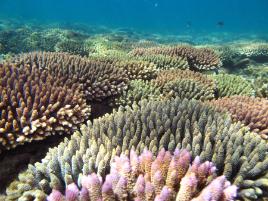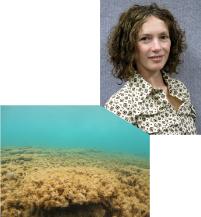Keppels may hold key to questions about the future of inshore reefs
Published on 25 Jul, 2012
Media Contact:For Immediate Release
Scientists researching reefs in the Keppel Islands region are well placed to come to grips with responses to disturbances including floods and extreme summers, but a mild, dry summer under the coming El Nino conditions is likely to be the best medicine for recovery from the 2011 floods to support a growing tourism economy.
That's according to reef researcher Dr Alison Jones of CQUniversity, who recently contributed to a showcase of research from the Keppel Islands during the International Coral Reef Symposium in Cairns.

Photo courtesy James Tan (JCU/AIMS)
Click here to View/Download full-sized Image
"The Keppel Islands in Central Queensland are one of the best researched inshore regions of the Great Barrier Reef Marine Park because they have such frequent disturbance events like floods with strong recovery," Dr Jones says. "Scientists seeking answers to research questions about how well reefs can survive disturbance are flocking to the Keppels because of this pattern and because the reefs are unique and highly accessible".
"However, even with the millions of dollars spent on Reef Rescue, the 2011 flood brought with it herbicides that exceeded individual ANZECC and ARMCANZ 200 guidelines for marine water quality at multiple sites.
"The water quality study was just one of the five ICRS conference presentations that featured research from Keppel Bay. The study, published in the international journal Marine Pollution Bulletin was a collaboration between several leading research agencies including the University of Queensland (ENTOX), CQUniversity, James Cook University, Queensland Health Forensic and Scientific Services the GBRMPA and DERM Rockhampton.

Dr Alison Jones beside an image she took of an area of dead coral.
Click here to View/Download full-sized Image
"Levels of specific herbicides present in inshore waters of the GBR can at times be present at levels which would inhibit photosynthesis in keystone primary producers such as seagrasses. However, the death of corals in the shallows in 2011 was a direct result of exposure to fresh water and we are not sure whether the herbicides remain in the system long enough to pose a problem for new corals as the reef regenerates."
A presentation by Dr Ray Berkelmans from AIMS and Dr Jones from CQUniversity described how corals can withstand 22 - 28 PSU and an exposure time of 3 - 16 days at the lowest and highest salinities, respectively. This study has just recently been published in the international journal Coral Reefs and is the first to pinpoint just how much fresh water some of the major reef-building corals of the Great Barrier Reef can withstand and for how long. This low salinity exposure threshold can now be used during future flood events to pinpoint the level of mortality reef managers can expect during a flood event.
Another presentation by James Tan also featured the flood impacts on corals including complete mortality of colonies on the reef flat at Halfway Island.
But probably the most profound research based in the Keppels is the study by a team led by one of the plenary speakers, Dr Geoff Jones from James Cook University, who has found that fishing reserves, which account for just 28% of the local reef area, produced approximately half of all juvenile fish recruitment to both reserve and fished reefs within 30km. The team's results provide compelling evidence that adequately protected reserve networks can make a significant contribution to the replenishment of populations on both reserve and fished reefs at a scale that benefits local stakeholders.
On the management side, Senior Marine Parks Ranger Chris Maple gave an outstanding presentation about the management of the Keppel Islands. Chris talked about the pilot no-anchor zones at Monkey, Big Peninsular, Humpy and Barren Islands and his department's bathymetry mapping of the eastern sides of the islands. His presentation also covered a recent total moratorium on coral collecting in the region as a result of the stewardship action plan by the Coral Fishery.
"The collection moratorium is probably a stitch in time for populations of anemones and anemonefish which have collapsed since the release of the movie ‘Nemo' and the 2006 bleaching," Dr Jones says.
Dr Jones' presentation outlined how bleached anemones can't host as many fish and can eventually disappear altogether.
"The bleaching event, along with the increased pressure of collecting for domestic aquaria have been key factors in the collapse of the anemone and anemonefish populations in this region.
"Even a 12-month moratorium at three sites initiated in 2009 has not made any difference to the populations which are struggling to recover after the bleaching event. The 2011 flood event caused further stress on the already struggling populations and they are unlikely to recover quickly as Geoff Jones' research shows that they are likely to be largely self-recruiting.
"A study by Anna Scott from the National Marine Science Centre in NSW has also shown that protecting them from collecting can really improve their chances of maintaining healthy populations. In the case of the Keppels, such frequent disturbance overlaid with the pressure of collecting is just not a good spot for a sustainable commercial industry."
Dr Jones says the ICRS in Cairns was a great way to showcase locally relevant research but it also highlighted the current pressures facing the region's reefs.
"For the reefs to regenerate after the 2011 flood event, we really need a long, dry period without major flooding and no thermal stress events during summer.
"CQUniversity is currently monitoring reef regeneration on sites that are of importance to the local tourism industry and an Honours student, Emma Asbridge will look at the potential for regeneration from sexual reproduction of corals.
"The pattern of recovery from the 1991 and other floods suggests that recovery will be slow in the first few years but that there will be a full recovery to pre-flood coral cover. What we have to remember is that coral cover in the Keppels is already much higher than other places on the GBR so even though we've had some coral loss, we still have some of the most spectacular inshore reefs of the entire Queensland coastline."
ENDS

